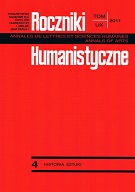Z kręgu zagadnień ciała i cielesności w cyklach obrazowych Genesis. Na wybranych przykładach sztuki średniowiecznej
Body and Carnality in the Scene of "Genesis". An Analysis of Selected Medieval Works of Art
Author(s): Małgorzata Urszula MazurczakSubject(s): Cultural history
Published by: Towarzystwo Naukowe KUL & Katolicki Uniwersytet Lubelski Jana Pawła II
Keywords: God the Creator; human being; body; carnality; senses; intellect; soul; apparel
Summary/Abstract: The Medieval imagery in the representations of the Genesis are profusely analysed in the literature of the subject. This is owing to the fact that the images in question cumulate a large number of interrelated religious motifs and ideas. The paramount motif is that of the Creator, whose presence was usually represented graphically by the figure of Christ with the crossnimbus. Other figures were also used as substitutes of God the Father. Figures of angels taking part in the consequent stages of creation are a frequent iconographic element, too. Irrespective of the above, the bodies and the carnality of Adam and Eve has been discussed only marginally, or completely ignored in the research on the Medieval imagery of the Genesis. Despite the common belief that Medieval art had no intense interest in the human body, the scenes depicting the creation of the human being reveal the artists' attempts to take up the theological discourse on the nature of carnality, bearing “God's image.” This paper points at a selection of patristic texts and those written by other authors who interpreted carnality in the context of the mystery of the human soul, intellect, human senses as well as the conditions relating to the sexual divide. The analysis is based on the most outstanding Medieval miniatures and reliefs that represent the relationship between the human being and the Creator in the moment of creating, first, Adam and then Eve. Special emphasis is placed on the artists' efforts to carefully represent the gestures of the Creator, which are to tell the spectator about the dignity of the human body as created by God. Also discussed are images that pinpoint the difference in the artistic positioning of the representation of God in relation to Adam and Eve. Some of the images show closeness and affinity, when God leans down towards the world in the act of creating man. In others, God sits on a globe, creating man by means of a divine gesture, but staying in a distance to His creation. A vital element in the way in which the first parents' bodies were painted was how a given artist emphasised or understated the anatomical features of Adam and Eve. Some artists even presented them as children, in an apparent need to give their own interpretation of their age. Yet another significant aspect in the analysis of how the human body was depicted is that of surroundings. The representations of the garden of Eden present nature, with special exposition of the ground on which the newly-created Adam is lying, a rock as well the trees and rivers in paradise.
Journal: Roczniki Humanistyczne
- Issue Year: 59/2011
- Issue No: 04
- Page Range: 5-28
- Page Count: 24
- Language: Polish

